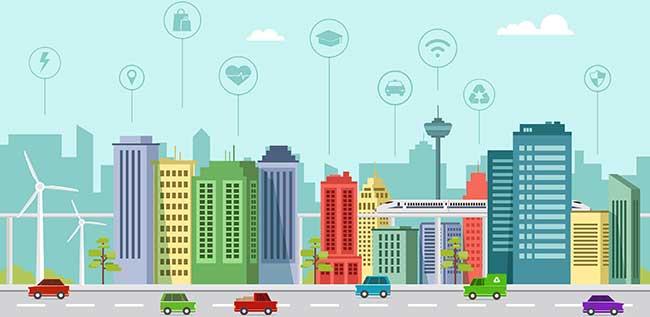
Aug 5, 2020
Blog Energy & Sustainability , Digital World What Will Cities Look Like In The Future?
Move over sprawl, the earth needs a more sustainable and efficient approach to city planning.
Today our planet is exploding in population and our environment is in peril. We must create new ways of living in large numbers in urban settings.
Advanced materials, technology and systems are being used to adapt to all our new Venices—cities born out of dire necessity, and one whose inhabitants were forced to invent new systems and structures to fit a unique set of environmental circumstances—all over the world.
The traditional method of growing cities, i.e “sprawl,” will no longer do.
Below is an overview of some of the tools we have in hand, and a look at what is coming next as we build cities that are connected, smart, made in new ways and out of brand new materials:
There will be new cities, ones where beloved historic structures still stand and forms of entertainment continue—but the delicate balance of the natural environment will no longer be ignored.
All cities, if they are to prosper and exist for future generations, will have to be designed and planned with this in mind. The environment is not waiting for us to improve our systems.
Through intelligence, creativity and technology, we will make all the cities of the world sustainable. Acknowledging that cities are part of the earth, not simply built on top of it, is the first step.
For additional intel into the future of cities, download a free overview of our report, Future Cities.

Sarah Greenberg is the Manager of Content Marketing at BCC Research. She creates our blog, social media and email content.

Electrical switches—devices that control the flow of electricity—are the backbon...

As the world accelerates toward net-zero emissions, hydrogen, and ammonia have e...

Hydrogen technology is widely used across industries like glass, fertilizer, met...

We are your trusted research partner, providing actionable insights and custom consulting across life sciences, advanced materials, and technology. Allow BCC Research to nurture your smartest business decisions today, tomorrow, and beyond.
Contact UsBCC Research provides objective, unbiased measurement and assessment of market opportunities with detailed market research reports. Our experienced industry analysts assess growth opportunities, market sizing, technologies, applications, supply chains and companies with the singular goal of helping you make informed business decisions, free of noise and hype.